Subduction tectonics of the Philippines
The subduction tectonics of the Philippines is the control of geology over the Philippine archipelago. The Philippine region is seismically active and has been progressively constructed by plates converging towards each other in multiple directions.[1] The region is bounded by subduction zones, where surrounding oceanic plates to the east and west slide towards the centre of the Philippine archipelago.[2][3] Subduction results in deep oceanic trenches, such as the Philippine Trench and Manila Trench, bounding the eastern and western sides of the Philippine archipelago, respectively.[4] The Philippine archipelago is also cut along its length by a left-lateral strike-slip fault known as the Philippine Fault.[5][1] The region is also known as the Philippine mobile belt due to its complex tectonic setting.[3]
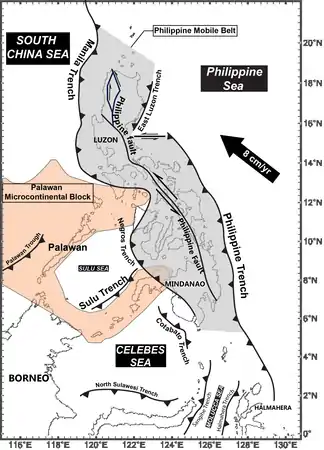
Active subduction disturbs the crust, leading to volcanic activity, earthquakes and tsunamis, making the Philippines one of the most hazard-prone regions on Earth.[4][6]
Tectonic units
Philippine Sea Plate
Philippine Sea Plate is an oceanic plate surrounded by subduction zones. The plate is moving northwest at a rate of 6 – 8 cm/year towards the Eurasian Plate.[7][6] Ranken and Cardwell (1984) showed that the rate of convergence increases southwards along the trench.[8][5][4] The plate rotates with respect to the pole closed to the triple junction of the Philippine Sea, Eurasian, and Pacific Plates at the northern tip of Philippine Sea Plate.[7][9][8] The rate of rotation is about 0.5˚/million years (Ma), yielding a total of approximately 90˚ rotation since early Tertiary.[7][9] It is generally suggested that the plate motion was kept about constant since 3 – 5 Ma,[7] but some study argued that the direction of plate propagation changed at about 1 Ma.[10]
Philippine Mobile Belt
The Philippine Mobile Belt (also called as Taiwan-Luzon-Mindoro Mobile Belt[11]) is a complex tectonic zone which sits at the convergence zone of the Eurasian Plate, Philippine Sea Plate and Indo-Australian Plate.[9] It covers the whole Philippine archipelago and extends southwards to the Molucca Sea and eastern Indonesia.[9][12] The belt is seismically active associated with frequent earthquakes and active volcanism.[4][12]
The Philippine mobile belt is bounded by convergence zones of different polarities: east-dipping subduction at Manila trench, Negros Trench, Sulu Trench and Cotabato Trench to the west; west-dipping subduction at Philippine Trench and East Luzon Trough mark its eastern boundary.[2][12][13] The belt is tectonically separated from surrounding plates, it is also regarded as an "independent block" or "microplate" in the Philippines.[6][14] Regardless of the uncoupling with surrounding tectonic units, the Philippine Mobile Belt has an affinity to both the Eurasian Plate and the Philippine Sea Plate.[15][2] It contains volcanic arc materials from the Philippine Sea Plate, as well as crustal materials from the Eurasian Plate.[9] It is very difficult to define a clear tectonic boundary as much information along the Philippine Mobile Belt is swept away by a strike-slip fault (Philippine Fault) traversing the mobile belt.[9]
Active Zones in the Philippine Mobile Belt
The Philippine Mobile Belt can be separated into two active zones: the "western active zone" and the "eastern active zone". The western active zone is bounded to the west by east-dipping subduction zone like the Manila Trench, whilst the eastern active zone is bounded to the east by west-dipping subduction zone like the Philippine Trench.[6] As the Philippine Mobile Belt sits in between the bipolar subduction of Eurasian Plate to the west and the Philippine Sea Plate to the east, the belt experiences East-West compression, resulting folds and thrusts zones.[6]
Philippine Fault Zone
The Philippine Fault is a left-lateral strike-slip fault which cuts across the Philippine archipelago behind the subduction zone. It is an NW-SE trending fault, which aligns subparallel to the Philippine Trench, extends from northern Luzon to Mindanao.[4][1][6] It is an important component in the Philippine Trench system in controlling regional geodynamics and kinematics.[6] R. Hall (1987) predicts the average velocity along the strike-slip fault is 0.5 cm/year,[16] while some of the other models predict the velocity of 2 – 3 cm/year.[1][6] However, models also agreed with the onset of Philippine Fault in between 2 – 4 Ma, and propagates southwards to the present southern termination at the northeast of Halmahera.[1][6][16]
Shear Partitioning Mechanism
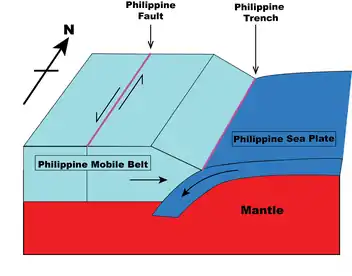
Shear partitioning mechanism in the Philippine fault-trench system was first proposed by Fitch in 1972.[17][1] In his model, the motion of plate convergence is partitioned into two components: Parallel to the fault, and perpendicular to the trench subduction. He suggested that the strike-slip fault is responsible for taking up stresses that cannot be accommodated by the subduction systems surrounding the Philippine Mobile Belt.[17] In the case of the Philippine Trench system, as the Philippine Sea Plate propagates towards the trench obliquely, the vector of displacement is broken down into two components: northward lateral motion of the "western active zone" of the Philippine Mobile Belt, and the westward subduction perpendicular of the Philippine Sea Plate.[1] The hypothesis of shear partitioning mechanism was agreed by Aurelio (2000), by tracking crustal movement using Global Positioning System (GPS) data.[1]
It has been hypothesised that the trench and fault formed in a synchronised manner,[1] both the trench and fault may propagate southwards since middle to late Miocene.[18][12][19]
More branching is observed over the northern and southern segments of the fault zone, which implies the Luzon and Mindanao–Moluccas regions are associated with a more complex tectonic setting.[1]
Palawan Microcontinental Block
The Palawan block is an aseismic microcontinent to the west of the Philippine Mobile Belt.[12] It originated from the southeastern continental margin of the Eurasian Plate. The Palawan continental block broke off from the Eurasian Plate during late Eocene,[20] and started colliding the Philippine Mobile Belt between Oligocene and Late Miocene.[12]
Geographically, Mindoro, Palawan Islands, northwestern Panay, Romblon Islands are also considered as the Palawan Microcontinental Block.[20]
Some models argued that the convergence of the two microcontinents, is thought to be the initiation of the development of the east-dipping subduction at Manila Trench and Negros Trench in Early Miocene, and subsequence the formation of the Philippine Fault Zone and Philippine Trench.[21][12]
Active subduction tectonics
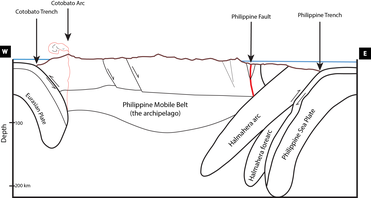
Subduction zones in the Philippine mobile belt can be characterised into two major groups: east-dipping subduction to the western boundary, and west-dipping subduction to the eastern boundary.[7][22][3]
Manila Trench
The Manila Trench results from eastward subduction of the Eurasian Plate (Sundaland Block) beneath the Philippine Mobile Belt. Subduction along the north-trending trench started in late-Oligocene to early-Miocene.[4][23][24] It has an average subduction rate at 1 – 2 cm/year, slowing towards the north.[23] It has a thick profile of sediment deposition in the well-developed forearc basin, this promoted the formation of accretionary wedge along the trench during compression.[24][23] Accretionary wedge could not be found in trenches over the eastern side of the Philippine mobile belt (e.g. along the Philippine Trench).[25]
Several east-dipping trenches could be found to the South of Manila Trench like Negros Trench and Cotabato Trench, they are formed after Manila Trench during middle-Miocene to late-Miocene, the sequence of initiation is from the North to South.[4]
Luzon Volcanic Arc
Luzon arc is a1200-km-long volcanic belt extending from Taiwan to southern Mindanao. It results from the subduction of Eurasian Plate beneath the Philippine Mobile Belt along the Manila Trench since early Miocene.[22] The age of volcanoes young towards the south from Taiwan. Subduction started in Taiwan 16 million years ago, but there were still young volcanoes which are dated up to quaternary in Mindanao.[4][26]
Palawan–Central Philippines collision zone
The collision between Palawan block and the central Philippine was initiated during early to middle Miocene. There are altogether three observed collision zones developed at different times, which are:[24]
- Romblon Island collision-related accretionary complex (Early Miocene)[24]
- Mindoro ophiolite complex (Middle Miocene–Pliocene)[24]
- South of Mindanao (Present)[24]
It is agreed that Romblon Island was the front-line of collision.[24] Collision zone between the Palawan microcontinental block and the Philippine mobile belt shows southwestern propagation through time. The mechanism behind the translation of the collision zone is still unidentified.[3]
Philippine Trench
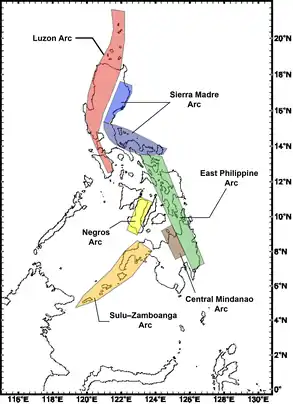
Philippine Trench results from the westward subduction of Philippine Sea Plate beneath the Philippine Mobile Belt. The north-trending trench extends from the southeastern Luzon (15˚30’N) to the northeast of Halmahera (2˚N), with a total length of 1,800 km (1,118 miles),[19][16] and a maximum depth of 10,540 meters (6,549 miles).[27] It is linked to another east-dipping subduction zone to the north in the East Luzon Trough with an E-W trending strike-slip fault. The Philippine propagates northwards in the segment of East Luzon Trench.[14][24][23]
The age of the Philippine Trench is not well-defined, some believed that the trench is 5 Ma or younger,[28][1] while some are 8 – 9 Ma.[29][22] However, researchers agree that the Philippine Trench is the youngest trench in the Philippine subduction system.[19][30][6][1] The Philippine Sea Plate moves towards the trench oblique way, force comes from the plate convergence cannot be accommodated by the trench itself solely, therefore, the activity of the trench is coupled with the strike-slip Philippine Fault.[1] It is believed that the Philippine Trench and fault zone formed and propagates southwards in a synchronised manner,[16][17][18][1][24] where they both formed during early Pliocene.[3] Subduction rate increases southwards, with the highest convergence near the southern termination in northeast Halmahera at a rate of 10 cm/year.[7]
Its origin is related to the collision between Palawan Microcontinental Block and the Philippine Mobile Belt, which activated the Manila Trench and subsequently initiated the Philippine Trench.[9][22][12][19]
Volcanic arcs
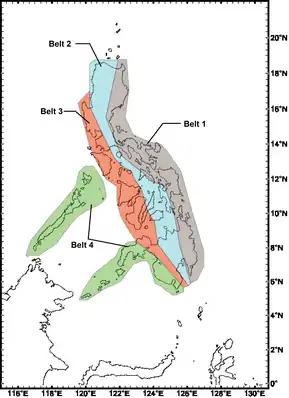
Ancient arc and recent arc systems can be identified in the Philippine archipelago. Magmatic events in the archipelago are related to plate subduction as reflected in the geochemistry of rocks. Rock composition along the major volcanic arc composition are generally calc-alkaline to tholeiitic magma series. There was also some reported occurrence of adakite, which is often associated with partial melting of basaltic component in subduction zone. Dating arc-derived rocks can constrain the timing for trench formation along with the tectonic evolution in Cenozoic.[32]
The geochemistry of recent arc formation since Oligocene is similar. The volcanic rocks also include high-potassium calc-alkaline series rocks, which reflect the island arc originality.[4] Volcanic arc formation also favours mineral deposits. Copper, gold and nickel mines are found in the Philippines.[33]
Ophiolitic belt
Ophiolites are suggested to be formed in subduction events in oceanic basins. The occurrence of ophiolite is common in the Philippines.[34] Studying ophiolite can help unveil the tectonic evolution of the Philippines.[31] The majority of ophiolite in the Philippines was formed in Cretaceous, with a minority formed in Tertiary.[31] Ophiolite in Philippines is zoned into four groups geographically: (i) Palawan zone; (ii) Western zone; (iii) Central zone; (iv) Eastern zone.[31][4] Dating of the ophiolitic belts shows a progressive younging trend from east to west, which formed in lower Cretaceous in the eastern belt to Eocene in the western belt. This shows the sequence of accretionary wedge formation from east to west. The youngest western ophiolitic zone is formed in the Sundaland – Philippine Mobile Belt boundary, while the older ophiolite is formed in proto-Philippine Plate, which is the basal rock in the Philippine Mobile Belt.[31][4]
Formation of the Philippine archipelago
Late Oligocene – Early Miocene
The west-dipping east-Luzon trough ceased activity during the late Oligocene. During Early Miocene, the Manila Trench was initiated, which is thought to be caused by the counterclockwise rotation of Luzon, subsequently led to the collision of Palawan microcontinental block and the Philippine mobile belt.[12][23] The Philippine mobile belt was accreted to the South China Sea block, forming the Manila Trench. The model was supported by structural and geological evidence.[12]
First, the suture zone, which is observed as metamorphic belts, marks the boundary between the Palawan block and the Philippine mobile belt.[12] This indicates the NE verging Palawan block in Miocene. Moreover, ophiolite emplacement is experienced in islands to the northeastern of Palawan. Ophiolite emplacement is a process when ophiolite is blended into the continental margin, which is thought to be collision-related. Furthermore, a gap of volcanism in the central Philippines is recorded,[3] which is also known to be caused by a collision event to the west of the Philippine mobile belt. And lastly, the coral reef bed was uplifted during the hypothesised collision episode, which reassures the collision event.[12]
Formation of Philippine Trench
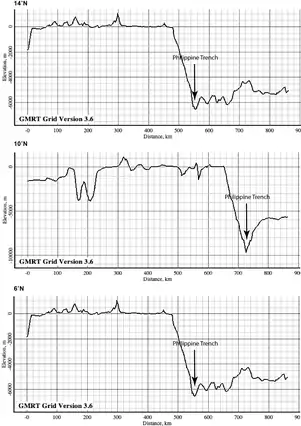
The collision of Palawan Block to the Philippine Mobile Belt was related to the formation of the Philippine Trench. It is argued that the formation of the Philippine Trench was to entertain the stress resulted from the Palawan collision.[35] Adding compressional stresses to the incipient subduction, it progressively developed into a subduction zone.[35]
The Philippine trench is known to be formed by recent subduction. It is deduced by the shallow subduction slab reflected by shallow seismicity and considering its subduction rate at the same time.[19]
Another hypothesis is that the Philippine Trench was originated near Bicol (around 13˚N) and propagates southwards to present termination abruptly at northeast Halmahera (2˚N).[7][16] This is supported by evidence such as variation of the age of volcanoes along the trench, depth of subduction slap and geometry of the trench.[19][22][8]
The hypothesis is supported by evidence of the age of arc volcanism along the Eastern magmatic arc. The oldest volcano is located in Bicol, with age of 6.5 Ma.[22] The progressive southwards younging trend of volcanoes along the trench from Bicol is observed, where the youngest subduction-related volcanic activities are observed right at the northeastern Halmahera.[22] The younging trend is also observed northwards from Bicol to the northern termination of East Luzon Trough. Supporting the hypothesis of northwards and southwards propagation of Philippine Trench from Bicol.[22]
The geometry of the trench also gives evidence supporting the hypothesis of both northwards and southwards propagation. Lallemand et al. (1990) proposed that the trench was first formed near 9˚N then propagated towards north and south, resulting in a relatively symmetrical geometry to the north and south of 9˚N.[19] The deepest part of the trench could be found around 9˚N, where the average depth of the trench is over 10,000 meters. The trench depth is progressively shallower to the north and to the south, with the depth near 8,000 meters at the southern terminal and around 6,000 meters at the northern terminal.[19]
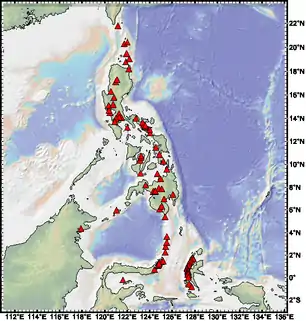
Tectonic hazards in the Philippines
Volcanoes
The Philippine archipelago is bounded by subduction zones which makes the region volcanically active. The most active volcano in the Philippines is the Mayon Volcano located in southeastern Luzon.[36] It is related to the subduction of Philippine Sea Plate beneath the Philippine mobile belt.[4]
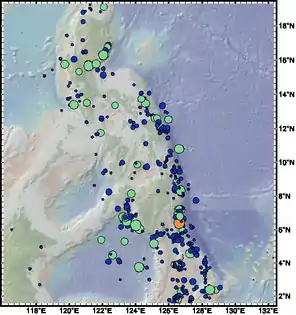
Earthquakes
Owing to the complex tectonic setting on the Philippine mobile belt, the Philippine archipelago is seismically active. Faults and subduction zones are the seismic origins. Among subduction zones in the Philippines, subduction along the Philippine Trench produces the most active and frequent seismic activities to the region. However, as Philippine Trench is a young subduction system, the majority are shallow earthquakes (< 30 km).[1]
References
- Aurelio, Mario A. (18 July 2008). "Shear partitioning in the Philippines: Constraints from Philippine Fault and global positioning system data: Shear partitioning in the Philippines". Island Arc. 9 (4): 584–597. doi:10.1111/j.1440-1738.2000.00304.x.
- David, Sevillo; Stephan, Jean-Francois; Delteil, Jean; Müller, Carla; Butterlin, Jacques; Bellon, Herve; Billedo, Elmer (August 1997). "Geology and tectonic history of Southeastern Luzon, Philippines". Journal of Asian Earth Sciences. 15 (4–5): 435–452. Bibcode:1997JAESc..15..435D. doi:10.1016/s1367-9120(97)00027-8.
- Yumul, Graciano P.; Dimalanta, Carla B.; Tamayo, Rodolfo A.; Maury, Rene C. (June 2003). "Collision, subduction and accretion events in the Philippines: A synthesis". The Island Arc. 12 (2): 77–91. doi:10.1046/j.1440-1738.2003.00382.x.
- Yumul, Graciano P.; Dimalanta, Carla B.; Maglambayan, Victor B.; Marquez, Edanjarlo J. (March 2008). "Tectonic setting of a composite terrane: A review of the Philippine island arc system". Geosciences Journal. 12 (1): 7. Bibcode:2008GescJ..12....7Y. doi:10.1007/s12303-008-0002-0. S2CID 140627389.
- Kreemer, Corné; Holt, William E.; Haines, A. John (July 2003). "An integrated global model of present-day plate motions and plate boundary deformation". Geophysical Journal International. 154 (1): 8–34. Bibcode:2003GeoJI.154....8K. doi:10.1046/j.1365-246x.2003.01917.x.
- Barrier, E.; Huchon, P.; Aurelio, M. (1991). "Philippine fault: A key for Philippine kinematics". Geology. 19 (1): 32–35. Bibcode:1991Geo....19...32B. doi:10.1130/0091-7613(1991)019<0032:PFAKFP>2.3.CO;2.
- Hall, Robert; Ali, Jason R.; Anderson, Charles D.; Baker, Simon J. (December 1995). "Origin and motion history of the Philippine Sea Plate". Tectonophysics. 251 (1–4): 229–250. Bibcode:1995Tectp.251..229H. doi:10.1016/0040-1951(95)00038-0.
- Ranken, B.; Cardwell, R. K.; Karig, D. E. (October 1984). "Kinematics of the Philippine Sea Plate". Tectonics. 3 (5): 555–575. Bibcode:1984Tecto...3..555R. doi:10.1029/tc003i005p00555.
- Rangin, Claude (October 1991). "The Philippine Mobile Belt: a complex plate boundary". Journal of Southeast Asian Earth Sciences. 6 (3–4): 209–220. Bibcode:1991JAESc...6..209R. doi:10.1016/0743-9547(91)90068-9.
- Nakamura, Kazuaki; Shimazaki, Kunihiko; Yonekura, Nobuyuki (1 January 1984). "Subduction, bending and education; present and Quaternary tectonics of the northern border of the Philippine Sea Plate". Bulletin de la Société Géologique de France. S7-XXVI (2): 221–243. doi:10.2113/gssgfbull.s7-xxvi.2.221.
- Pinet, Nicolas; Stephan, Jean François (November 1990). "The Philippine wrench fault system in the Ilocos Foothills, northwestern Luzon, Philippines". Tectonophysics. 183 (1–4): 207–224. Bibcode:1990Tectp.183..207P. doi:10.1016/0040-1951(90)90417-7.
- Yumul, Graciano P.; Dimalanta, Carla B.; Tamayo, Rodolfo A. (September 2005). "Indenter-tectonics in the Philippines: Example from the Palawan Microcontinental Block - Philippine Mobile Belt Collision". Resource Geology. 55 (3): 189–198. doi:10.1111/j.1751-3928.2005.tb00240.x.
- Cardwell, R. K.; Isaacks, B. L.; Karig, D. E. (1980). "The spatial distribution of earthquakes, focal mechanism solutions, and subducted lithosphere in the Philippine and Northeastern Indonesian Islands". The Tectonic and Geologic Evolution of Southeast Asian Seas and Islands. Geophysical Monograph Series. 23. pp. 1–35. doi:10.1029/gm023p0001. ISBN 978-0-87590-023-0.
- Rangin, C.; Jolivet, L.; Pubellier, M. (1 November 1990). "A simple model for the tectonic evolution of Southeast Asia and Indonesia region for the past 43 m.y". Bulletin de la Société Géologique de France. VI (6): 889–905. doi:10.2113/gssgfbull.VI.6.889.
- Mitchell, A.H.G.; Hernandez, F.; dela Cruz, A.P. (January 1986). "Cenozoic evolution of the Philippine archipelago". Journal of Southeast Asian Earth Sciences. 1 (1): 3–22. doi:10.1016/0743-9547(86)90003-6.
- Hall, Robert (December 1987). "Plate boundary evolution in the Halmahera region, Indonesia". Tectonophysics. 144 (4): 337–352. Bibcode:1987Tectp.144..337H. doi:10.1016/0040-1951(87)90301-5.
- Fitch, Thomas J. (10 August 1972). "Plate convergence, transcurrent faults, and internal deformation adjacent to Southeast Asia and the western Pacific". Journal of Geophysical Research. 77 (23): 4432–4460. Bibcode:1972JGR....77.4432F. doi:10.1029/jb077i023p04432. hdl:2060/19720023718. S2CID 128887836.
- Macpherson, Colin G. (2008). "Lithosphere erosion and crustal growth in subduction zones: Insights from initiation of the nascent East Philippine Arc" (PDF). Geology. 36 (4): 311. Bibcode:2008Geo....36..311M. doi:10.1130/g24412a.1.
- Lallemand, Serge E.; Popoff, Michel; Cadet, Jean-Paul; Bader, Anne-Gaelle; Pubellier, Manuel; Rangin, Claude; Deffontaines, Benoît (10 January 1998). "Genetic relations between the central and southern Philippine Trench and the Sangihe Trench". Journal of Geophysical Research: Solid Earth. 103 (B1): 933–950. Bibcode:1998JGR...103..933L. doi:10.1029/97jb02620. S2CID 128741954.
- Padrones, Jenielyn T.; Tani, Kenichiro; Tsutsumi, Yukiyasu; Imai, Akira (July 2017). "Imprints of Late Mesozoic tectono-magmatic events on Palawan Continental Block in northern Palawan, Philippines". Journal of Asian Earth Sciences. 142: 56–76. Bibcode:2017JAESc.142...56P. doi:10.1016/j.jseaes.2017.01.027.
- Bellon, Hervé; P. Yumul Jr, Graciano (August 2000). "Mio-Pliocene magmatism in the Baguio Mining District (Luzon, Philippines): age clues to its geodynamic setting". Comptes Rendus de l'Académie des Sciences - Series IIA - Earth and Planetary Science. 331 (4): 295–302. doi:10.1016/S1251-8050(00)01415-4.
- Ozawa, Ayako; Tagami, Takahiro; Listanco, Eddie L.; Arpa, Carmencita B.; Sudo, Masafumi (March 2004). "Initiation and propagation of subduction along the Philippine Trench: evidence from the temporal and spatial distribution of volcanoes". Journal of Asian Earth Sciences. 23 (1): 105–111. Bibcode:2004JAESc..23..105O. doi:10.1016/s1367-9120(03)00112-3.
- Hayes, Dennis E.; Lewis, Stephen D. (1984). "A geophysical study of the Manila Trench, Luzon, Philippines: 1. Crustal structure, gravity, and regional tectonic evolution". Journal of Geophysical Research. 89 (B11): 9171. Bibcode:1984JGR....89.9171H. doi:10.1029/jb089ib11p09171.
- Karig, D. E. (1982). "Initiation of subduction zones: implications for arc evolution and ophiolite development". Geological Society, London, Special Publications. 10 (1): 563–576. Bibcode:1982GSLSP..10..563K. doi:10.1144/gsl.sp.1982.010.01.37. S2CID 128799881.
- Marova, N.A. (October 1964). "Geomorphology of the area of the Philippine trench". Deep Sea Research and Oceanographic Abstracts. 11 (5): 839–844. Bibcode:1964DSRA...11..839M. doi:10.1016/0011-7471(64)90952-0.
- Polve, Mireille; Maury, Rene C.; Jego, Sebastien; Bellon, Herve; Margoum, Ahmed; Yumul, Graciano P.; Payot, Betchaida D.; Tamayo, Rodolfo A.; Cotten, Joseph (June 2007). "Temporal Geochemical Evolution of Neogene Magmatism in the Baguio Gold–Copper Mining District (Northern Luzon, Philippines)". Resource Geology. 57 (2): 197–218. doi:10.1111/j.1751-3928.2007.00017.x.
- Killerich, A. (1977). "Bathymetric Features of the Philippine Trench". In Brunn, Anton Frederick (ed.). The Galathea Deep Sea Expedition, 1950-1952, described by members of the expedition. pp. 155–172. OCLC 610373425.
- Karig, D. E.; Sarewitz, D. R.; Haeck, G. D. (1 October 1986). "Role of strike-slip faulting in the evolution of allochthonous terranes in the Philippines". Geology. 14 (10): 852–855. Bibcode:1986Geo....14..852K. doi:10.1130/0091-7613(1986)14<852:ROSFIT>2.0.CO;2.
- Marchadier, Yves; Rangin, Claude (November 1990). "Polyphase tectonics at the southern tip of the Manila trench, Mindoro-Tablas Islands, Philippines". Tectonophysics. 183 (1–4): 273–287. Bibcode:1990Tectp.183..273M. doi:10.1016/0040-1951(90)90421-4.
- Wu, Jonny; Suppe, John; Lu, Renqi; Kanda, Ravi (June 2016). "Philippine Sea and East Asian plate tectonics since 52 Ma constrained by new subducted slab reconstruction methods". Journal of Geophysical Research: Solid Earth. 121 (6): 4670–4741. Bibcode:2016JGRB..121.4670W. doi:10.1002/2016jb012923.
- Yumul, Graciano P. (June 2007). "Westward younging disposition of Philippine ophiolites and its implication for arc evolution". Island Arc. 16 (2): 306–317. doi:10.1111/j.1440-1738.2007.00573.x.
- Yumul, G. P. (December 2000). "Thematic issue: Philippine Geology". The Island Arc. 9 (4): 457. doi:10.1046/j.1440-1738.2000.00293.x.
- Lyday, Travis Q. (2002). "The Mineral Industry of the Philippines". U.S. Geological Survey Minerals Yearbook. The Bureau. p. 21.2.
- Encarnación, John (8 November 2004). "Multiple ophiolite generation preserved in the northern Philippines and the growth of an island arc complex". Tectonophysics. 392 (1): 103–130. doi:10.1016/j.tecto.2004.04.010.
- "Geologic and paleomagnetic evidence for a possible Miocene collision in western Panay, central Philippines". Deep Sea Research Part B. Oceanographic Literature Review. 29 (12): 776–777. January 1982. Bibcode:1982Geo....10..325M. doi:10.1016/0198-0254(82)90198-4.
- "Mayon". Volcano World. Oregon State University.